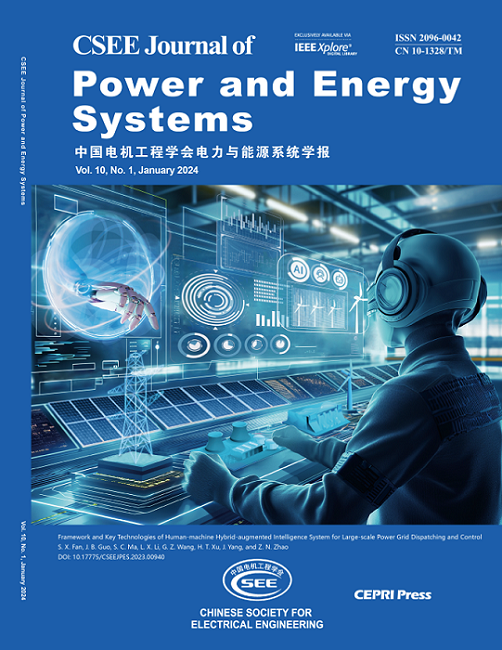气电一体化输电系统的可行性分析与设计
IF 5.9
2区 工程技术
Q2 ENERGY & FUELS
引用次数: 0
摘要
越来越多的大型可再生能源发电厂正在产生充足的电力。随着电转气和电转x技术成为利用剩余电力增强能源系统灵活性的有前景的方式,提出了一种创新的气电集成传输系统(GEITS),将电力与氢气或其他气体产品共同传输,具有结构紧凑、安装成本低、能量容量大等可预见的优势。探讨了GEITS的可行性,提出了GEITS的设计准则,并给出了GEITS在不同应用场景下的运行技术参数。根据高压氢气的电强度计算GEITS基准天然气管道的尺寸和运行压力,进而计算GEITS标称电压。通过温升模拟计算得出GEITS的标称电容值大于其他传输线的标称电容值。此外,高压流动氢气作为电绝缘体是一个新课题,并通过比例模型实验验证进行了研究。虽然与静态氢气相比,未观察到0.4 m/s流动氢气对放电特性的影响,但在2.4 m/s流动氮气中,放电受到损害。未来的工作将研究高压长距离氢气间隙在雷击试验下的电强度和高流速氢气的放电现象。具有较高绝缘性能的甲烷和甲烷混氢能提高标称电压。本文章由计算机程序翻译,如有差异,请以英文原文为准。
Feasibility Analysis and Design of Gas-Electricity Integrated Transmission System
An increasing number of large-scale renewable plants are generating abundant electricity. As power-to-gas and power-to-x technologies become promising ways to utilize surplus electricity to enhance the flexibility of energy systems, an innovative gas-electricity integrated transmission system (GEITS) to co-transmit electricity and hydrogen or other gas products is proposed, with the foreseeable advantages of compact structure, lower installation cost, and larger energy capacity. This paper investigates the feasibility of GEITS, suggests a design guideline, and gives the operation technical parameters of GEITS in different application scenarios. The dimensions and operating pressures of GEITS benchmark natural gas pipelines and then the nominal voltages of GEITS are calculated based on the electrical strength of high-pressure hydrogen. The nominal ampacities of GEITS are evaluated by temperature-rising simulations, which are larger than those of other transmission lines. Furthermore, high-pressure flowing hydrogen acting as an electrical insulator is a novel topic, and it is investigated via experimental validation on a scale model. Although the effect of 0.4 m/s flowing hydrogen on discharge characteristics has not been observed compared to static hydrogen, the discharge is impaired in 2.4 m/s flowing nitrogen. Future works will investigate the electrical strength of high-pressure long-distance hydrogen gaps under lightning impulse tests and the discharge phenomenon in higher flowing-velocity hydrogen. Methane and methane blended with hydrogen with higher insulation performance can increase the nominal voltages.
求助全文
通过发布文献求助,成功后即可免费获取论文全文。
去求助
来源期刊

CSEE Journal of Power and Energy Systems
Energy-Energy (all)
CiteScore
11.80
自引率
12.70%
发文量
389
审稿时长
26 weeks
期刊介绍:
The CSEE Journal of Power and Energy Systems (JPES) is an international bimonthly journal published by the Chinese Society for Electrical Engineering (CSEE) in collaboration with CEPRI (China Electric Power Research Institute) and IEEE (The Institute of Electrical and Electronics Engineers) Inc. Indexed by SCI, Scopus, INSPEC, CSAD (Chinese Science Abstracts Database), DOAJ, and ProQuest, it serves as a platform for reporting cutting-edge theories, methods, technologies, and applications shaping the development of power systems in energy transition. The journal offers authors an international platform to enhance the reach and impact of their contributions.
 求助内容:
求助内容: 应助结果提醒方式:
应助结果提醒方式:


